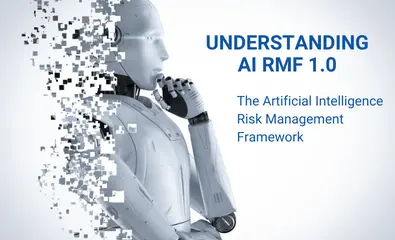Written by Tathagat Katiyar & Harshitha Chondamma II
Artificial Intelligence is undergoing continuous growth and development, with new technologies and applications being developed daily. As AI becomes more prevalent and integrated into various industries, it is critical to ensure that these systems are trustworthy, secure, and transparent. This is where the Artificial Intelligence Risk Management Framework 1.0 (AI RMF 1.0) from the National Institute of Standards and Technology (NIST) comes in. This framework provides organizations with guidelines and best practices to help them confidently develop, deploy, and operate AI systems.
In this blog, we will cover NIST AI RMF 1.0 in-depth, including its features, benefits, and how organizations can use it to ensure AI systems meet high security and compliance standards.
On January 26, 2023, the National Institute of Standards and Technology (NIST) under the U.S. Department of Commerce) released a Risk Management Framework for Artificial Intelligence (AI RMF). The AI RMF is designed to assist companies in managing risks and promoting responsible development while deploying or using AI systems. Although compliance with the AI RMF is voluntary, it can be helpful for companies seeking to manage their risks, particularly in light of regulators’ increased scrutiny of AI.
The Artificial Intelligence Risk Management Framework helps organizations to establish a systematic approach for information security and risk management activities focusing explicitly on Artificial Intelligence. A robust AI risk management framework offers organizations asset protection, reputation management, and optimized data management. It can also protect against competitive advantage, legal risks, and missed business opportunities.
What is NIST AI RMF 1.0?
The NIST AI RMF 1.0 is a set of standards and practices for evaluating, maintaining, and improving the trustworthiness of AI systems. AI RMF 1.0 provides an adaptable, structured, and quantifiable process that enables organizations to address AI risks. The aim is to assist organizations in understanding the risks associated with AI, developing strategies to manage those risks, and evaluating the trustworthiness of AI systems prior to deployment.
Organizations may voluntarily determine compliance with AI RMF 1.0. The framework is designed for organizations that operate, develop, or deploy AI systems. It also applies to government agencies, non-profit organizations, and private companies. Additionally, it can serve as a reference guide for meeting regulatory and compliance requirements and enhancing their AI systems’ performance, transparency, and trustworthiness.

Salient Features of NIST AI RMF
The AI RMF consists of two main components:
Section 1
The first section outlines how organizations can frame AI risks and the features of trustworthy AI systems.
Section 2
This forms the framework’s core and includes four specific functions to help organizations address risks associated with AI systems. These include:

1. Govern: Guides organizations on how to develop governance structures and processes for AI risk management.
2. Map: Advises organizations on identifying, assessing, and prioritizing AI risks.
3. Measure: Helps organizations evaluate and monitor AI systems to ensure they perform as intended and per the organization’s risk management objectives.
4. Manage: Assists organizations in implementing risk mitigation strategies and managing AI risks over time.
Objectives of NIST AI RMF
The framework is designed to be voluntary, preserve rights, be non-sector specific, and be agnostic to use cases. This gives organizations of all sizes, sectors, and industries the flexibility to implement the ideas in the framework. The core objectives are to:
• Provide a resource to companies creating, developing, deploying, or utilizing AI systems.
• Assist organizations in managing various risks associated with AI.
• Promote the development and usage of AI systems that are trustworthy and responsible.

Bias in AI extends beyond ensuring demographic balance and representative data. In other words, an AI system may still pose problems even if it distributes predictions evenly across different demographic groups. For example, it may be inaccessible to people with disabilities or perpetuate inequalities caused by the digital divide.
The AI RMF categorizes biases into three groups:
Systematic Bias
This type of bias is related to the design and operation of AI systems and can occur during the development and deployment of AI systems. It refers to the possibility of an AI system producing incorrect or unfair results due to errors or biases in the system’s design or operation.
- Computational and Statistical Bias
Flaws introduce computational bias in the design or operation of an AI system, such as errors in the algorithms or computational processes. As a result, decisions may be made based on incomplete or inaccurate information. On the other hand, statistical bias is introduced by flaws in the data used to train the AI system, for example, if the training data is biased. Both computational and statistical biases can significantly impact the trustworthiness and accuracy of AI system outputs.
- Human Cognitive Bias
This is the most prevalent type of bias which occurs due to an individual or group’s subjective interpretation of the data generated by the AI system.
AI RMF Guidelines
Organizations working with AI systems should implement the following programs, policies, procedures, and controls including:
• Governance and Management
It aims to set up processes for AI systems to ensure effective decision-making, accountability, and risk management. This includes forming an AI Governance Committee, establishing a decision-making Change Advisory Board, implementing a risk assessment and management strategy, conducting regular audits, and hiring external auditors.
• Technical and Operational Considerations
This encompasses crucial elements in creating, deploying, and developing AI systems, focusing on ensuring safety, security, clarity, and privacy. The approach involves implementing policies and procedures for security, software development, and operations, adopting a data governance policy, and creating a training program for proper AI system use.
• Performance and Evaluation
It focuses on establishing guidelines for evaluating the reliability and performance of AI systems, including testing, monitoring, and validation. This involves monitoring key performance and risk indicators for AI systems, performing rigorous testing and periodic monitoring, and conducting periodic reviews to measure and validate the effectiveness of AI systems.
NIST AI RMF Compliance
Organizations developing and deploying AI solutions must adhere to the NIST Risk Management Framework (RMF) to ensure their AI systems’ trustworthiness. This includes companies that create AI-based products, services, and applications and organizations that utilize AI in their operations. Additionally, any company that handles sensitive data and assets must comply with the NIST RMF to secure these assets from unauthorized access or modification.
The NIST AI Risk Management Framework has global applicability and does not have specific regional compliance requirements. However, it is expected to be widely adopted as a set of guidelines and best practices for managing AI-related risks in the United States and other regions. The framework can assist organizations of all sizes in improving their AI risk management strategies.
Summary
AI RMF 1.0 helps organizations understand AI risks, create strategies for managing them, and evaluate AI systems’ trustworthiness before deployment. It helps organizations adopt responsible AI practices and ensure trustworthy AI systems. It covers governance and management, technical and operational considerations, as well as performance and evaluation.
The Accorian Advantage
Accorian’s experienced cybersecurity and compliance experts provide personalized guidance for organizations’ information security initiatives. With a results-driven methodology and exceptional client service, Accorian delivers cost-effectiveness and expertise to every client they serve. The facts speak for themselves.




